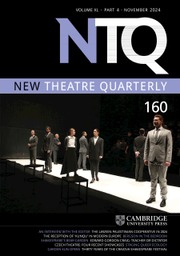No CrossRef data available.
Article contents
Othello: A Moor Rorschach Test
Published online by Cambridge University Press: 10 October 2024
Abstract
The evolution of the colour of Othello’s skin-tone is a surprisingly accurate cultural barometer of attitudes towards race in the eyes of scholars. A significant portion of the critical literature is focused upon the Moor’s complexion as one of the main variables within the play. Yet the fact that the script has itself become a variable, and not a constant, has been neglected. This text’s transformation can be traced alongside the ratification of racial laws. In Jacobean England, Antebellum American, and Imperial Germany, audiences respectively experienced Othello committing divergent crimes, ranging from murder-suicide, to marriage, to simply existing. These countries’ racial legislation coloured the various audience interpretations of the Moor. While Othello’s actions were always the same, the public projected their own attributed meanings onto the play – a practice analogous to a living Rorschach test. This article explores the concept of using a metaphorical Rorschach test as a tool for the historicization of the many colours of Othello.
Keywords
- Type
- Research Article
- Information
- Copyright
- © Cambridge University Press, 2024



